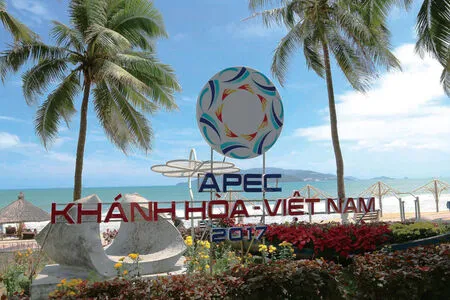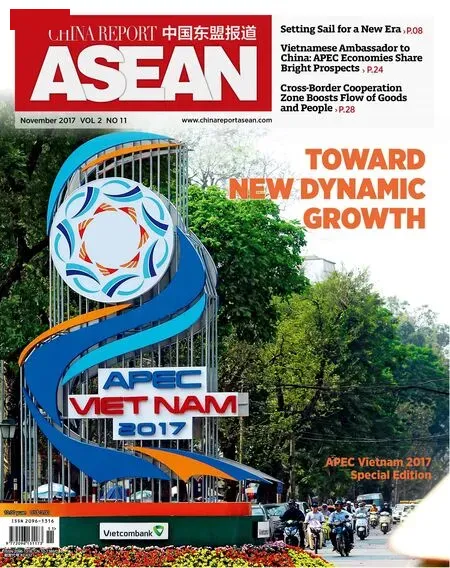COOPERATION BRINGS PROSPERITY TO THE ASIA-PACIFIC REGION
2017-11-22ByWangZhe
By Wang Zhe
COOPERATION BRINGS PROSPERITY TO THE ASIA-PACIFIC REGION
By Wang Zhe
APEC serves as an important mechanism that makes a real difference to the regional economy
Since its inception in 1989 as a regional economic forum and consultative body, the Asia Pacific Economic Cooperation (APEC) has evolved into the highest-level mechanism for economic cooperation in the Asia-Pacific region, covering an extensive part of the world and wielding significant influence.It has played an inalienable part in regional trade and investment liberalization, as well as economic and technological cooperation between member economies.
The goal of APEC cooperation is to build a dynamic and harmonious Asia-Pacific community by championing free and open trade and investment, promoting and accelerating regional economic integration, encouraging economic and technical cooperation, enhancing human security and facilitating a favorable and sustainable business environment.
For more than two decades,APEC has witnessed rapid development of the Asia-Pacific region. In the future, it will find new ways to promote regional cooperation and build a harmonious Asia-Pacific community for more prosperity in the region.
For more than two decades,APEC has witnessed rapid development of the Asia-Pacific region.
Trade and Investment Liberalization
At the end of the 1980’s,the Cold War was nearing its end. When the proposal was made by Australia and other countries to carry out economic cooperation in the Asia-Pacific region, all economies in the region felt it necessary to strengthen economic cooperation and integration for prosperity. The first ministerial meeting of APEC, held in the Australian capital Canberra on Nov. 5-7, 1989, opened the curtain of APEC cooperation.In 1991, after complex and difficult negotiations, China officially joined APEC. In 1993,initiated by the United States,the APEC Economic Leaders’Meeting was institutionalized,starting the process for leaders of the economies in the region to jointly promote cooperation, as well as realize regional economic integration and prosperity. The core of APEC cooperation surrounds economics and trade. However,since 9/11, all leaders have seized the opportunities of the summit meetings to exchange views with their counterparts on the hot issues of the time in the informal setting of APEC.
In November 1993, the First APEC Economic Leaders’Meeting was held in Seattle in the United States. Trade and investment liberalization was set as the major goal of APEC cooperation. At that time, most developing countries were shortof necessary funds for national economic development.They hoped to gain access to international direct investment.That’s why APEC’s goal won across-the-board support of member economies. At the summit meeting in Bogor,Indonesia in November 1994,the leaders endorsed the Bogor Goals that aim for free and open trade and investment in Asia-Pacific by 2010 for industrialized economies and by 2020 for developing economies. The subsequent summit meetings worked out concrete steps to implement the Bogor Goals.

Da Nang, Vietnam is prepared for the 2017 APEC Economic Leaders'Meeting.
The 1997 Asian financial crisis had a negative impact on the confidence of APEC member economies, but it did not change the original purpose of APEC.After some adjustment, the leaders’ meeting returned to its original path focusing on trade and investment liberalization.More steps were taken to implement the Bogor Goals. In 2001, China hosted the APEC summit in Shanghai, marking the first time the event has been held in the country. The 2008-2009 financial crisis had a global touch. However, by 2010,there was record recovery in trade volume in the Asia-Pacific region. APEC had made a crucial contribution to this success.
In recent years, the world economy has experienced modest recovery with downturn risks. Faced with the common challenge of achieving sustainable growth, all Asia-Pacific economies agreed on pushing forward regional economic integration and the building of the Free Trade Area of the Asia Pacific (FTAAP). The 2014 APEC summit in Beijing started the FTAAP process and drew a new blueprint for comprehensive connectivity and infrastructure development in the region.APEC has made fruitful efforts in promoting the construction of the regional free trade area.
Sustained High-Speed Development
Over the 20-plus years of APEC cooperation, the performance of Asia-Pacific economies has been eye-catching. The Asia-Pacific region at the end of the Cold War was generally backward with sluggish growth, with the United States and Japan being notable exceptions. Since 1993, however,nearly all APEC economies have experienced rapid growth. In 1993, the total GDP of the region’s 21 economies was US$14.8 trillion. By 2003, the number had grown to US$22.1 trillion,an increase of 49.3 percent. By 2013, total GDP further increased to US$42.6 trillion, almost twice the 2003 amount. In recent years, the development of APEC economies has maintained strong momentum. Following the drastic growth of total GDP,the per capita GDP of member economies has also grown by a large margin.
APEC’s efforts have driven regional trade prosperity.The international trade of all the member economies has continuously grown. In 1993, the total amount of the international trade of all APEC member economies was US$3.5 trillion. In 2003, it reached US$7 trillion, and by 2013, it further increased to US$18.2 trillion. In recent years, this fine momentum has continued.China’s performance in this regard has made it the world’s largest trading nation.
APEC has also exerted influence upon people’s lives.The reduction of tariff and nontariff barriers makes regional economic communication less costly and more efficient and convenient. Interconnectivity brings about cooperation projects and job opportunities,which means higher income and higher living standards for the population of member economies. With regional economic integration, the people of regional economies will enjoy the privilege of specialty commodities from other economies at lower costs.
Tang Guoqiang, chairman of the China National Committee of Pacific Economic Cooperation (PECCChina), commented that although the region’s economy was affected by the twists and turns of the 1997 Asian financial crisis, the 2008 submortgage crisis of the United States and the European debt crisis, the Asia-Pacific region has maintained a high level of sustained prosperity and development for quite some time. A main contributor to these achievements is APEC’s unremitting pursuit for regional economic prosperity. APEC’s total GDP and international trade have amounted to almost half of the world’s total for the past several years. The excellent performance of China and other developing economies has contributed to the shaping of the Asia-Pacific region as the world’s growth center.
Trade and investment liberalization was set as the major goal of APEC cooperation. At that time,most developing countries were short of necessary funds for national economic development.
They hoped to gain access to international direct investment.That’s why APEC’s goal won acrossthe-board support of member economies.
The 1997 Asianfinancial crisishad a negative impact on the confidence of APEC member economies, but it did not change the original purpose of APEC.
APEC cooperation surrounds economics and trade. However,since 9/11, all leaders have seized the opportunities of the summit meetings to exchange views with their counterparts on the hot issues of the time in the informal setting of APEC.
In 2001,Chinahosted the APEC summit in Shanghai.
